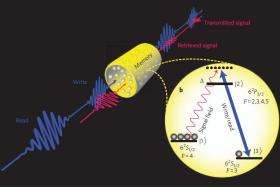April 1, 2010 feature
Physicists demonstrate 100-fold speed increase in optical quantum memory

(PhysOrg.com) -- As with today's computers, future quantum computers will require more than just quantum information processing; they will also require methods to store and retrieve the quantum information. For this reason, physicists have been studying different types of quantum memories, which are capable of controllably storing and releasing photons. However, these memories still face several challenges in areas including storage time, retrieval efficiency, the ability to store multiple photons, and bandwidth.
In a new study, a team of physicists, Klaus Reim, et al., from the UK, US, and Canada has focused primarily on increasing the bandwidth of an optical quantum memory. The researchers have achieved data rates that exceed 1 GHz, which is more than 100 times greater than the speed of existing quantum memories. Although other areas still need improvement, these high-speed memories will likely form the basis of tomorrow’s photonic quantum information processors.
In their experiments, the physicists use a hot cesium vapor cell as the storage medium. They overlap a signal pulse containing several thousand photons (the information) with a strong write pulse, and send both pulses together into the cesium vapor cell. The vapor induces a Raman interaction, mapping the signal pulse with the write pulse into a collective atomic excitation called a spin wave. This information can then be stored in the cesium vapor cell for 12.5 nanoseconds, after which the information is retrieved by sending a strong read pulse into the cell. The read pulse converts the spin wave into an optical signal that is measured by a detector.
“There are a few steps that are required [to achieve high bandwidth], but the main approach is to use atoms with a higher energy storage state, and to apply more sophisticated control pulse methods,” coauthor Ian Walmsley of the University of Oxford told PhysOrg.com.
By achieving bandwidths up to 1 GHz, the new quantum memory offers data rates that are an increase of a factor of more than 100 compared to current quantum memories, which are limited to a few megahertz. Moreover, the researchers noted that the bandwidth was limited only by the response time of the detector; theoretically, the quantum memory could be capable of even larger bandwidths. In addition, the method offers long coherence times of several microseconds. One area that still needs work is the overall efficiency, which was about 15%. The cesium vapor could store 30% of the incoming signals, half of which could later be retrieved. The researchers plan to improve the efficiency by changing the signal pulse’s attributes.
The physicists also noted that this Raman-based quantum memory scheme can be broadly applied to other storage media besides hot cesium vapor, such as cold gases and solid-state systems. Also, in addition to quantum computing, quantum memories like this one will be important for quantum repeaters for long-distance communication.
“Our plans are to demonstrate the operation of the memory at the quantum limit, using an external source of nonclassical light,” Walmsley said. “Challenges for the future in general are to increase the number of bits the memory can store and the readout efficiency of the memories to the point when they can be used in applications such as quantum communications links.”
More information: K. F. Reim, et al. “Towards high-speed optical quantum memories.” Nature Photonics. Doi: 10.1038/NPHOTON.2010.30
Copyright 2010 PhysOrg.com.
All rights reserved. This material may not be published, broadcast, rewritten or redistributed in whole or part without the express written permission of PhysOrg.com.



















